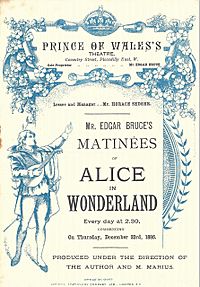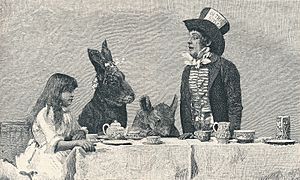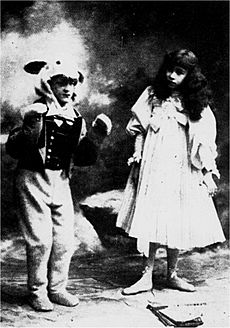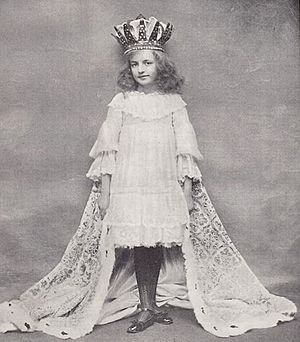Alice in Wonderland (musical) facts for kids
Quick facts for kids Alice in Wonderland |
|
|---|---|

Programme for the original production of Alice in Wonderland (1886)
|
|
| Music | Walter Slaughter |
| Lyrics | Lewis Carroll, Henry Savile Clarke and Aubrey Hopwood |
| Book | H. Savile Clarke |
| Basis | Lewis Carroll's novels Alice's Adventures in Wonderland and Through the Looking-Glass |
| Productions | 1886 West End West End revivals in 1888, 1898, 1900, 1906, 1908, 1910, 1914, 1915, 1916, 1921, and 1927 |
Alice in Wonderland is a fun musical based on Lewis Carroll's famous books. These books are Alice's Adventures in Wonderland (from 1865) and Through the Looking-Glass (from 1871).
Henry Savile Clarke wrote the story and some of the songs. Walter Slaughter created the music, and Aubrey Hopwood wrote more song lyrics. This musical was called "A musical dream play in two acts" and became very popular. Lewis Carroll himself asked Slaughter to keep some of the old tunes in the songs, like "Bonny Dundee."
Contents
How the Musical Began
Before this musical, there were many small plays of Alice put on by amateur groups. Lewis Carroll even thought about making a professional play himself.
Carroll's Idea for a Musical
In 1877, Carroll wrote to Arthur Sullivan. Sullivan was famous for his music in the Gilbert and Sullivan operettas. Carroll wanted Sullivan to write songs for an Alice musical. Sullivan liked the idea and offered to compose the music if Carroll wrote the story.
Carroll was a bit unsure, partly because Sullivan's fee was quite high. He wanted to know what he would get for his money. So, Carroll suggested Sullivan write just one or two songs first. After this, their plan to work together didn't happen.
Henry Savile Clarke's Version
In August 1886, a writer named Henry Savile Clarke asked Carroll if he could adapt Alice in Wonderland for the stage. Carroll said yes, but he had some important rules. He wanted a written promise that the play would not include anything rude or inappropriate. He also said the play should be like an operetta, not a pantomime.
Carroll was very involved in making the musical. He helped with everything, from changing the book into a play to choosing the actors. He picked a young actress named Phoebe Carlo to play Alice. He even bought her costumes himself and sent her for acting lessons. Dorothy D'Alcourt, who played the Dormouse, was only six and a half years old!
The musical opened on December 23, 1886, at the Prince of Wales Theatre in London. A newspaper called The Theatre said the play was "beautifully mounted" (meaning it looked great) and "splendidly acted." They praised Phoebe Carlo as Alice and Dorothy D'Alcourt as the Dormouse. The music by Walter Slaughter was also called "charming." This musical was brought back to the stage many times over the next 40 years.
What Happens in the Musical
The musical has two main parts, called acts.
Act I: Alice's Adventures in Wonderland
This act has two scenes: "A Forest in Autumn" and "A Glade in Wonderland."
The story begins with fairies around Alice, who is asleep under a tree. Alice then meets all the famous characters from the book. These include the White Rabbit, the Caterpillar, the Duchess with her Baby, and the Cook who uses too much pepper. She also meets the Cheshire Cat with his amazing smile.
Later, Alice joins the Mad Hatter, the March Hare, and the Dormouse at their never-ending tea party. They ask her riddles and are a bit rude. Then, a big parade of cards appears. Alice isn't scared and tells the Queen of Hearts that they are "only a pack of cards." She refuses to see heads chopped off! Alice even dances with the Cards in a graceful gavotte (a type of dance). She also protects her friend, the Cheshire Cat, from being unfairly punished.
The Gryphon and the Mock Turtle then appear. They teach Alice about the sea. The first act ends with the trial of the Knave of Hearts, who is accused of eating the tarts. Alice says he's innocent, and everyone agrees!
Act II: Through the Looking Glass
This act has four scenes: "Through the Looking Glass," "The Garden of Live Flowers," "A Sea-Shore," and "The Banqueting Hall – The Forest Again."
In the second act, Alice goes into the world of Through the Looking-Glass. She meets the chess pieces and a chorus who dance stiffly. The Red Queen gives her advice after Alice talks to the live flowers. Then, Tweedledum and Tweedledee show up. Alice quickly becomes friends with these big twins. She tries hard to stop them from fighting, but it's no use.
After seeing the hungry Walrus and Carpenter eat their oysters, Alice helps Tweedledum and Tweedledee get ready for their fight. But a Crow arrives, and the warriors quickly run away. Humpty Dumpty appears on his wall. The play continues until Alice is back asleep in her chair. She wakes up and says, "Oh! I've had such a curious dream!"
Songs
Here are some of the songs from the musical:
Act I – In Wonderland
- No. 1 - Chorus - "Sleep, Alice, sleep as we circle around thee"
- No. 2 - Alice - "How doth the little crocodile improve his shining tail"
- No. 3 - Alice - "'You are old, Father William,' the young man said"
- No. 4 - Duchess - "Speak roughly to your little boy and beat him when he sneezes"
- No. 5 - Alice & Cheshire Cat - "Cheshire Pussy thanks to thee"
- No. 6 - Hare, Hatter and Alice - "The poor Hatter's very mad, so they say, so they say"
- No. 6a - March
- No. 7 - Gavotte of Cards - "King, Queen and Knave, here we are seen, dancing."
- No. 7a - Entrance of Executioner - "Here comes the Executioner!"
- No. 8 - Executioner's Chorus, with Queen and King - "He is the executioner"
- No. 9 - Mock-Turtle - "Beautiful soup, so rich and green"
- No. 10 - Gryphon - "'Will you walk a little faster,' said a whiting to a snail"
- No. 11 - Alice - "'Tis the voice of the lobster I hear him declare"
- No. 12 - Finale Act I - "'Not guilty,' I declare"
Act II – Through the Looking-Glass
- No. 1 - Chorus - "Here ranged in due order of battle we stand with Red King and White King and Queens on each hand"
- No. 2 - Red Queen - "'Twas brillig and the slithy toves did gyre and gimble in the wabe"
- No. 2a - Entrance of Lily and Rose
- No. 2b - Entrance
- No. 2c - Exit
- No. 2d - Waltz - Alice and Flowers
- No. 2e - Hatter's Entrance
- No. 2f - Alice - "Tell me why you look so wild and strange"
- No. 3 - "Tweedle-Dum and Tweedle-Dee agreed to have a battle"
- No. 4 - Chorus - "Here we go round the Mulberry bush"
- No. 4a - Entrance of Walrus and Carpenter
- Nos. 5 & 6 - Oyster Scene - "The Carpenter is sleeping, the butter's on his face"
- No. 7 - Alice - "Humpty Dumpty sat on a wall, Humpty Dumpty had a great fall"
- No. 8 - Chorus of Children - "Humpty Dumpty's fallen down, Humpty Dumpty, Humpty Dumpty's broke his crown"
- No. 9 - Chorus - "The Lion and the Unicorn were fighting for the Crown"
- No. 10 - Hatter - "When the wind is in the East, on new-laid eggs I always feast!"
- No. 10a - Change of Scene
- No. 11 - Chorus - "Sound the festal trumpets, set the bells a-ringing"
- No. 12 - Finale - "Alice's health, long life and wealth, never a monarch so mighty was seen"
Extra Songs
- "Flowerland" - "Flow'rs awake from out your long repose, snowdrops peep from under Winter's snow"
- "Naughty Little Bunny" - "When a rabbit's good as gold, always does what he is told"
Original Cast (1886)
Here are some of the actors who performed in the very first show:
Act I – Alice's Adventures in Wonderland / Act II – Through the Looking-Glass
- Alice – Phoebe Carlo
- White Rabbit/Red King – Master D. Abrahams
- Caterpillar/ Unicorn – Master S. Solomon
- Duchess/Lily – Florence Levey
- Cook/White King – Anna Abrahams
- Cheshire Cat/ Lion – Charles Adeson
- Hatter/Tweedledum – Sidney Harcourt
- Hare – Edgar Norton
- Dormouse/Plum Pudding – Dorothy D'Alcourt
- King of Hearts/White Knight – Stephen Adeson
- Queen of Hearts/Red Queen – Mdlle. Rosa
- Knave of Hearts/White Queen – Kitty Abrahams
- Executioner/The Carpenter – Mr. H. H. H. Cameron
- Gryphon/The Walrus – Charles Bowland
- Mock Turtle/Humpty Dumpty – William Cheesman
- Rose – Mabel Love
- Red Knight – C. Kitts
- Tweedledee – John Ettinson
- Leg of Mutton – Master Hood
Later Shows
The Alice in Wonderland musical was brought back to the stage many times. It was often performed during the Christmas season in London's West End for about 40 years after it first opened.
Some of the places it was shown include:
- The Globe Theatre in 1888, with Isa Bowman playing Alice.
- The Opera Comique in 1898.
- The Vaudeville Theatre in 1900, with some new music added.
- The Savoy Theatre in 1908 and again in 1910, 1914, 1916, and 1927.
- The Duke of York's Theatre in 1915.
- The Garrick Theatre in 1921.
Many adult actors also joined the mostly young casts in these later shows. For example:
- Irene Vanbrugh played the Knave of Hearts in 1888.
- Ellaline Terriss was Alice and Seymour Hicks was the Hatter in 1900.
- Marie Studholme played Alice in 1906.
- Dan Leno performed in 1909.
- C. Hayden Coffin was the Hatter in 1913 and 1921.
Images for kids






